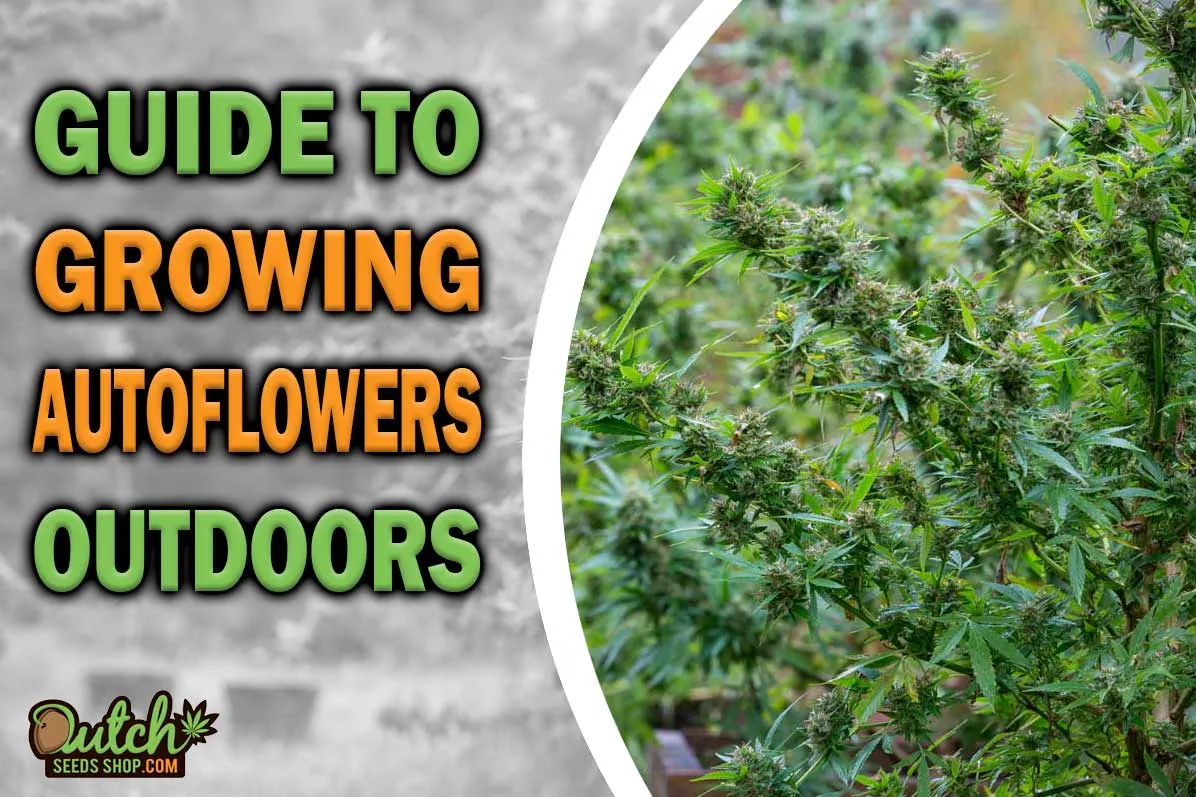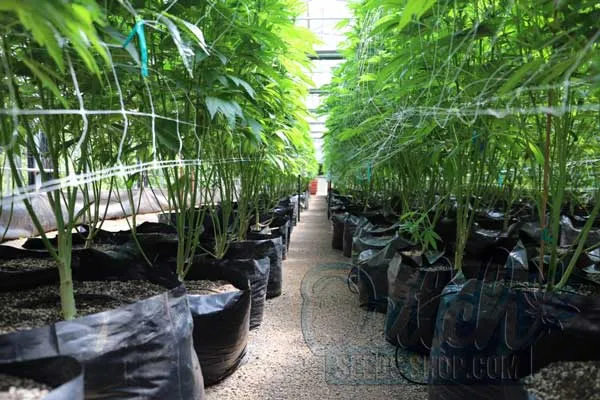How To: Growing Autoflowering Seeds Outdoors
So, you’re looking to dip your green thumbs into the wonderful world of cannabis cultivation? Well, you’re in the right place, my soon-to-be bud buddies. Get ready to embark on a truly elevating journey, growing your autoflower cannabis seeds outdoors. 🌱

The Fast Track to Harvest
Unlike their photoperiod cousins, autoflowers are the Usain Bolts of the cannabis world.
They’re off to the races the moment you plant them, sprinting towards a bountiful harvest in a record 8 to 12 weeks.
No complicated climate controls, no rigorous light schedule, just pure, manageable growth.
Their relatively small stature means they fit into all kinds of nooks and crannies in your garden.
Talk about convenient!
Choosing the Right Pot Size and Location
The saying ‘bigger is better’ may seem cliché, but it rings true when it comes to pot sizes for autoflowers.
The pot is like your plant’s first apartment – make sure it’s spacious enough for them to grow but not so large they feel lost.
In general, medium autoflowers prefer a 5 to 7 US gal (19 to 26 L) pot, a cozy abode that gives their roots ample space to stretch and explore.

On the other hand, the more formidable autoflowers enjoy the comforts of an 11-US gal (42 L) pot, offering more room to spread their roots and shoot toward the sky.
But a pot is nothing without its location.🌳
In this grand theater of green thumbs, sunlight is the show’s star, and your autoflowers are its biggest fans.
So, stage your pots in a location that basks in at least 8 hours of direct sunlight daily.
Remember, a well-lit location promotes a dramatic increase in growth, resulting in a stellar yield that will earn a standing ovation.
Soil, Nutrients, and Watering
Autoflowers are not the picky princesses of the plant world, but they appreciate well-draining slightly acidic soil.
Think of soil like a five-star restaurant for your plant’s roots, complete with a nutrient-rich menu (and the occasional glass of champagne 🥂).
And speaking of hydration, your autoflowers enjoy a drink about once per day, especially during the first week of planting.
Overwatering can drown their roots (and their spirits), so think of their water needs like a fine wine – not too much, not too little, just enough to get them singing in the rain.
Embrace the Sun: Light Requirements for Autoflowers
Autoflowers are like little sunbathing beauties, soaking up the sun rays all day long.
They don’t need a strict light schedule, but they’re happiest when they get 8 hours of direct sunlight or more.
The more sun, the more photosynthesis, the more growth, and the more buds.
It’s as simple as that! 🌞

Outdoor Growing Tips and Tricks
Autoflowers may be the speedy Gonzales of the cannabis world, but they still appreciate a little TLC.
These plants may grow so fast that pests barely have time to send an RSVP, but that doesn’t mean unwanted guests won’t attempt to crash the party.
If you spot any creepy crawlies, don’t panic.
You can gently show them the exit with organic pest control methods, keeping your plants as the star performers.
Furthermore, consider introducing some training techniques to make the most of your autoflower growth.
It’s like a fitness boot camp for your plants, pushing their branches to the limit, and encouraging them to multiply their bud sites, thus boosting your overall yield.
However, remember to stop your training regimen once they start flowering.
Like a performer in the middle of their spotlight solo, no autoflower likes to be disturbed when the main act is on!
Climate Considerations
Regarding climate, autoflowers are like weathered sailors; they can handle much fluctuation.
But, like most plants (and people), they prefer to be comfortable.
The ideal temperature range is 18-25°C with humidity around 60%.

Sativa-dominant hybrids might be your pick for hotter climates, while Indica-dominant hybrids can weather colder climates like champs.
Germination and Planting
To start your journey, you’ll need to germinate your autoflower seeds into sprouting roots, a process called germination.
Just remember to treat them gently.
They’re baby plants, after all.
Once they’ve sprouted, it’s time to plant them in their final home.
Be it a pot or directly into the ground, ensure your babies have room to grow and soak up the sunlight.
Outdoor Growth Stages
In the exciting narrative of an autoflower’s life, there are three major acts – the seedling stage, the vegetative stage, and the flowering stage.
Each stage has its script of needs and potential plot twists that must be addressed vigilantly.
The seedling stage is like the overture, setting the tone for what’s to come.
Here, your sprouting autoflowers will need a bit of extra care.
This stage is quickly followed by the vegetative stage, where your plants develop their character, grow taller, and expand their leafy wardrobe.
And then comes the grand finale – the flowering stage.
Around weeks 4-6, your plants will emit a distinctive aroma, their signature perfume, indicating that they are ready to flower.
It’s their way of saying, “Get ready; the best is yet to come!”
This unique fragrance is a tell-tale sign that the bud show is about to start.
So, sit back, relax, and enjoy the spectacle of your autoflowers blooming into their full, magnificent potential.
Maximizing Yield and Quality
Your end goal is a bountiful harvest of high-quality buds.
To achieve this, pay attention to plant spacing, bud density, and the number of bud sites.
Remember that cannabis is like a competitive sibling – it doesn’t like to share its space or its nutrients.
Give your plants room to breathe, and they’ll reward you with a monster yield.

Harvesting, Drying, and Curing
Once your plants have worked their magic, it’s time to harvest.
But don’t rush this stage; timing is everything.
Wait for the trichomes (the tiny resin glands on your buds) to ripen, then pick your buds, trim them, and hang them up to dry.
Curing your buds is like letting a good wine age; it only improves with time.
Aim for curing them in an airtight container at around 70°F (22°C) and 60-65% relative humidity for 2 to 4 weeks.
Your patience will be rewarded with smooth, flavorful smoke.
Pros and Cons of Outdoor Growing
Outdoor growing is simple, cost-effective, and can produce excellent yields.
Plus, who doesn’t love the great outdoors? However, it does expose your plants to the elements and potential pests.
But with some planning, precaution, and a healthy dose of love, you’ll be a proud parent of a thriving cannabis garden in no time.

FAQ
Are Autoflowers good outside?
Yes, their growth cycle and flowering ability make them perfect for the outdoors.
How do you maximize autoflower yield outdoors?
Regular watering, quality soil, sufficient light, and plant training techniques are essential.
How much yield does an outdoor Autoflower produce?
Yields can range from 0.9 to 5.3 ounces (25 to 150 grams) per plant.
How often do you water outdoor Autoflowers?
Typically once per day, but adjust based on weather and soil.
How much longer do Autoflowers take outside?
They might take 8 to 12 weeks.
What is the best soil for autoflower outside?
Well-draining, slightly acidic soil enriched with organic matter.
About the Author
Share the Love:
